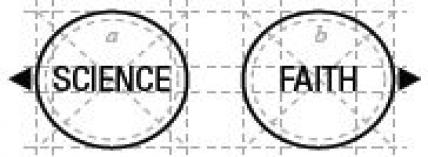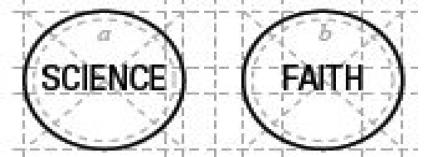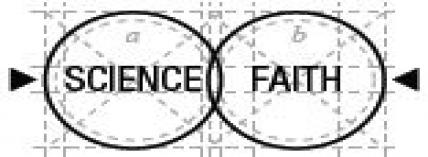Test of FAITH
Ways of understanding science and religion
People have often debated just what the relationship between science and religion is. In the past twenty years historians have begun to question whether there is even a ‘relationship’ between the two, preferring instead to describe the complexity of interactions between science and religion.
There are a number of models that can be useful for understanding how science and faith interact. These models can be either descriptive – simply describing how science and religion relate, or prescriptive – telling us how science and religion should relate. No single model can really do the situation justice, but together they are useful for beginning to think about the interrelationships between science and faith.

Conflict. Among the people who support the conflict model are atheistic scientists such as Richard Dawkins, who declare that science and religion are at war with each other and that science will win the war. Others, such as Young Earth Creationists (who believe the first chapters of Genesis provide a scientific account of the creation of the world), believe that religion will win the war. There is no doubt that at times there has been conflict between science and religion, or at least between particular scientific and religious views, but there are often other ways of understanding the situation. The most important points that count against this model are that religion provided the foundations for modern science, and that many successful scientists have held (and still hold today) religious beliefs without seeing any conflict between their faith and science.

Separation. The basic idea in this model is that science and religion ask different kinds of questions about the world. Science seeks to understand how things work, while religion asks the ‘why’ questions. But, throughout history, key figures in science have been motivated by their religious beliefs. And it’s difficult to see how anyone could separate these two areas of their life: ‘The scientist with religious beliefs working in a research team at the laboratory bench on Mondays is the same person who worships God communally in church on Sundays.’ [1]
Science and religion may ask different kinds of questions, but they are each addressing the same reality, the same world. For this reason, it is not easy to draw a clear separation between the two.

Fusion. This model blurs the distinction between scientific and religious types of knowledge. Those who advocate fusion use the content of science to determine the content of religious belief, and vice versa. The danger of building religious belief on science is that while the details of scientific theories change over time, for Christians, the Word of God in the Bible is unchanging.

Complementarity. This model suggests that science and religion provide complementary insights by addressing the same reality from different perspectives. Explanations derived from science and religion do not have to rival one another. They can be understood as different ways of looking at the same thing. Thus, a scientist who is also a Christian can understand the world as the creation of God while still seeking scientific explanations for things in the world and for the origins of the world itself. In this model, science can be understood as investigating God’s creation. The best thing about this approach is that it values both science and religion as ways of understanding the world.
References
[1] Denis Alexander, ‘Models for Relating Science and Religion’ (Faraday Paper No. 3).
Go to Test of Faith - an introduction
© Faraday Institute 2008-2010
This briefing sheet is a part of the Faraday Institute's Test of FAITH resources. Used with the kind permission of the Test of FAITH project, The Faraday Institute for Science and Religion, www.testoffaith.com.



